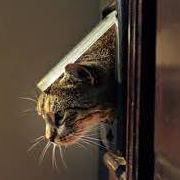MONTHLY BLOG 120, ISAAC NEWTON, WORLD RENOWNED PHYSICIST & INVENTOR OF THE CAT FLAP!?
If citing, please kindly acknowledge copyright © Penelope J. Corfield (2020)

| Downloaded from https://www.catsbest.eu/catsbest_en (Nov. 2020) |
Nothing wrong with a special cat-sized doorway, of course.1 A cat flap is a handy device. But was it really invented in the late seventeenth century by Sir Isaac Newton (1643-1727), the renowned physicist and mathematician?2 He was certainly a man of great ingenuity, with practical as well as theoretical powers. One important invention reliably attributed to Newton was his construction of the world’s first reflecting telescope. It incorporated specially-ground mirrors instead of refracting lenses, to remove even the slightest distortions of vision. The result was a sharper, clearer image. Today the Newtonian telescope bears his name, in tribute to its parentage.3
But Sir Isaac Newton, inventor of the cat flap? It was not that the great scientist was too grand for small matters of moment in the daily life of his contemporaries. He was for many years an energetic Master of the Mint, personally tracking down counterfeiters and dealers in clipped money.4 Indeed, Newton was a polymath, making interventions in physics, mathematics, optics and mechanics, as well as in theology and alchemy. For such a busy man, a moment spent devising a cat-flap would seem all in a hectic day’s work.
There is also a humorous side to the story. It seems to date from the early nineteenth century, and was recounted by a scholar in Newton’s Cambridge College, Trinity.5 There were apparently two holes in the stout wooden door to the rooms inhabited by the great physicist in the early 1660s. It was there that Newton had, apparently, his eureka moment. Annoyed at being disturbed by a cat repeatedly seeking to enter and leave, he cut one hole for the adult cat and, next to it, a smaller one for her kitten.6 (One version of the story has Newton cutting three small holes for three kittens). Aha! ‘Even Homer nods’, as the saying has it. Later generations could laugh indulgently at the great scientist, who had apparently overlooked the obvious fact that her kittens could easily pass through the mother cat’s aperture. Even a Newton, while gazing at the cosmos, can make simple errors on his own doorstep.
And so was born an urban legend. There is in fact no evidence that Newton, who was a self-sufficient intellectual and psychological loner, had any close physical relationships either with his fellow humans (whatever his private desires) or with domestic pets. Nonetheless, urban legends variously provide him with a cat, named Spithead; and, for good measure, a dog, named Diamond. These ‘facts’ are regularly repeated on the web, despite much debunking. And, as with all legends, they are continuously embroidered and developed.
Newton is likely therefore to retain his web-title as inventor of the cat-flap for some years to come. The fact that various apertures cut for scavenging cats in barn- and farm-doors had existed for centuries – even for millennia – does not manage to halt the mythology. One venerable cat-hole survives at the Chetham Library, Manchester, built 1421;7 and some others are still to be found.
|
French carved oak door with cat hole, c.1450-1500: from Wikimedia Commons (2020). |
Nonetheless, people like to have specific dates and details for specific developments.8 So Sir Isaac Newton provides a neat time-line for the feline-friendly cat-flap. Moreover, the homely invention humanises his glittering but distinctly remote genius. It brings the international sage down to earth – and salutes him with a hint of ironic laughter too. All very well, as long as the Newtonian cat-flap is recalled purely as unverified urban legend – without the specificity of the Newtonian telescope or the Newtonian laws of gravity.
ENDNOTES:
1 This is my fourth and last BLOG on eighteenth-century cats. They are collateral outputs from detailed research, on which see P.J. Corfield, ‘“For I will Consider my Cat Jeoffry”: Cats and Literary Creativity in Eighteenth-Century Britain’, work-in-progress for publication 2021
2 Among a huge literature, see I.B. Cohen, The Newtonian Revolution (Cambridge, 1980); J. Gleich, Isaac Newton (2003); R. Iliffe, Priest of Nature: The Religious Worlds of Isaac Newton (Oxford, 2017); N. Guicciardini, Isaac Newton and Natural Philosophy (2018).
3 For context, see G. Andersen, The Telescope: Its History, Technology and Future (Oxford, 2007).
4 J.H.M. Craig, Newton at the Mint (Cambridge, 1946).
5 ‘A Trinity-Man’ [J.F.M. Wright], Alma Mater: Or, Seven Years at the University of Cambridge (1827), Vol. 1, p. 17,
6 https://3milliondogs.com/catbook/did-you-know-issac-newton-invented-the-cat-flap/.
7 https://library.chethams.com/.
8 A verified development in recent times is the invention of the microchip cat-flap after years of research (2005-7), by Dr Nick Hill, like Newton a Cambridge physicist:
For further discussion, see Twitter
To read other discussion-points, please click here
To download Monthly Blog 120 please click here

